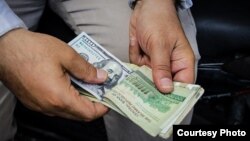Iran's currency has hit another record low against the dollar, six weeks before the United States is due to reimpose sanctions on Iranian oil exports that are Tehran's main revenue source.
The Bonbast.com website, which tracks Iran's unofficial exchange rates, showed a new low of 16,000 tomans, or 160,000 rials, to the dollar Monday.
The rial has weakened to a series of record lows against the U.S. currency in recent weeks. Bonbast.com displayed the rial at a record low of 128,000 to the dollar on Sept. 3.
Iran's official exchange rate, set by its central bank, has stood at 42,000 to the dollar since April.
The Trump administration has vowed to reinstate sanctions on Iranian oil exports on Nov. 4, in a bid to pressure Tehran to give up what the U.S. says is its nuclear weapons ambitions.
Iran denies seeking nuclear weapons. Washington reimposed a first set of economic sanctions on Iran last month as part of the pressure campaign. The moves reverse the previous U.S. administration's suspension of those sanctions under terms of a 2015 nuclear deal between Iran and six world powers.
Speaking to VOA Persian last Friday in an interview broadcast Monday, U.S. economist Steve Hanke of Johns Hopkins University said Iranians should expect more of the same with their currency.
"The Iranian people already have anticipated the problems that will befall them after the sanctions go back on, and they react much more rapidly, of course, than anyone," Hanke said. "That is why the rial has been plummeting and inflation has been soaring."
A weakening rial makes dollar-denominated imports more expensive for Iranians.
In a Monday tweet, Hanke said Iran's annual inflation rate has hit a record high of 293 percent.
In a graphic posted with the tweet, Hanke said he calculated the rate using data from Bonbast.com, Iran's central bank and the U.S. Bureau of Labor Statistics.
"It is impossible to predict how low the Iranian currency will go," Hanke said. "We just know it is dying. And when currencies die, inflation goes up, the economy tends to be completely destabilized, and society in general becomes destabilized because [people] can't trust their own money."
This article originated in VOA's Persian Service.






